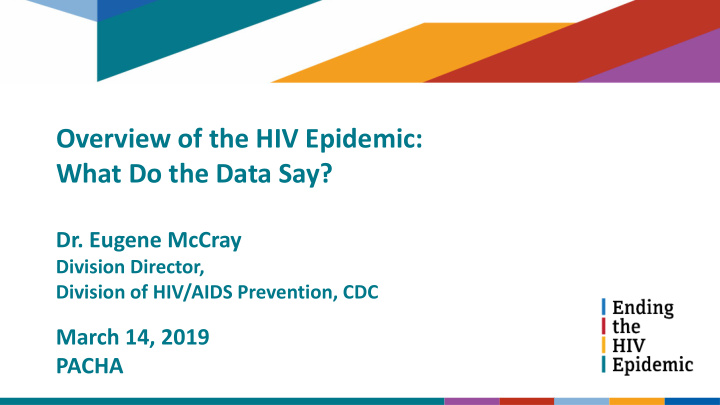



Overview of the HIV Epidemic: What Do the Data Say? Dr. Eugene McCray Division Director, Division of HIV/AIDS Prevention, CDC March 14, 2019 PACHA
https://www.cdc.gov/hiv/pdf/library/reports/surveillance/cdc-hiv-understanding-the-impact-of-HIV-Diagnoses.pdf
Diagnoses
NEW HIV DIAGNOSES HAVE DECLINED SUBSTANTIALLY BUT PROGRESS IS STALLED *40,142 diagnoses in 2016 * Data includes diagnoses from the US and 6 dependent areas Source: https://www.cdc.gov/hiv/pdf/library/reports/surveillance/cdc-hiv-surveillance-report-2017-vol-29.pdf 4
HIV DISPROPTIONATELY AFFECTS GROUPS African Americans account From 2012-2016, HIV diagnoses among American Indians/ Alaska for 44% of HIV diagnoses, but comprise only 13% of U.S. population Natives increased 34% https://www.cdc.gov/hiv/pdf/library/reports/surveillance/cdc-hiv-surveillance-report-2017-vol-29.pdf 5 **Data for the year 2017 are preliminary and based on 6 months reporting delay
48 COUNTIES, 7 STATES WITH SUBSTANTIAL RURAL BURDEN, DC AND SAN JUAN ACCOUNT FOR 50% OF NEW DIAGNOSES Data on burden of HIV in the US shows areas whereHIV transmission occurs more frequently. More than 50%of new HIV diagnoses* occurred in only 48 counties, Washington DC and 1 municipality in San Juan, Puerto Rico. In addition, 7 states have a substantial rural burden – with over 75 cases and 10% or more of their diagnoses in rural areas. *2016-2017 data
Incidence
HIV INFECTIONS STARTED TO STABILIZE IN 2013 MAJOR PROGRESS 1980s peak incidence near 130,000 annually 1985 - 2012 interventions have driven infections down to <50,000 annually
PREVENTION AND TREATMENT NOT REACHING THOSE WHO COULD BENEFIT MOST
National and State Progress
HIV Prevention Progress Report (HPR) 2019 First time that CDC has produced a report that includes both national and state level indicators Reports on progress of 21 key HIV prevention and care indicators Reflects DHAP Strategic Plan and national indicator reporting activities NHAS 2020, HP 2020, GPRA, UNAIDS Includes 7 state level indicators (where available) for 50 states and District of Columbia
National Progress: Summary Indicator Status Met Target - 8 indicators (38%) Progress - 9 indicators (43%) No progress - 4 indicators (19%)
HPR PrEP Indicator By 2020, increase the number of persons prescribed pre-exposure prophylaxis (PrEP) by at least 500 percent National Progress In 2016, there were 64,763 persons who were prescribed PrEP. The 2016 target (17,937) for persons prescribed PrEP was exceeded. The 2020 target (47,832) has been met.
PrEP use has increased among gay and bisexual men at risk for HIV between 2014-2017 Increase in PrEP Increase in PrEP USE AWARENESS among MSM among MSM 6% 60% to to 35% 90% 14
HIV HAS COST AMERICA TOO MUCH FOR TOO LONG 700,000 Without intervention and despite American lives lost to HIV since 1981 substantial progress another 400,000 Americans will be newly diagnosed $20 billion over 10 years despite the available Annual direct health expenditures by U.S. tools to prevent infection government for HIV prevention and care 15
16 16
Recommend
More recommend